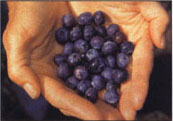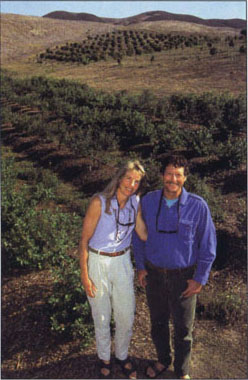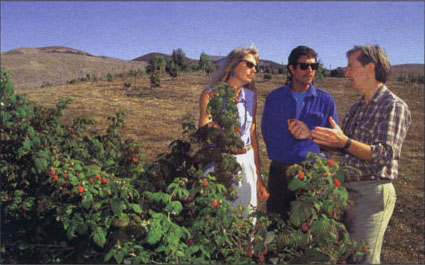All Issues
Growing blueberries frustrates farmers, but opens doors
Publication Information
California Agriculture 53(6):10-11.
Published November 01, 1999
PDF | Citation | Permissions
Full text
Chuck and Jennifer Lenet never expected blueberry farming to be so tough.
“It's been hard and frustrating for us,” Jennifer Lenet says. “Blueberries are finicky plants. I'm not sure it's worth it.”
But the very challenges of growing blue-berries, says UC Small Farm Program farm advisor Mark Gaskell, may be the secret to the Lenets' eventual success.
“Somebody is already growing all the easy crops,” Gaskell says. “Chili peppers, snow peas and summer squash are chronically in oversupply. But the blueberry market in September will suddenly switch to offshore fruit from New Zealand and the price at supermarkets will be $3 to $4 per half-pint. That's the market we're after.”
In the late 1980s, the Lenets were running a successful Morro Bay landscaping business when they began a search for their dream farm.
“We wanted a change,” Lenet says. “We wanted to live and work on the same property out in the country.”
It took 5 years, but they found what they were looking for in an 80-acre parcel near Cayucos: excellent soil, a good water supply, southern exposure and a location close to the coast but outside the coastal fog zone.
They contemplated growing avocados, a common crop on California's Central Coast, but after consulting with Gaskell, decided to focus on blueberries.
Blueberries are native to the northeastern United States and have traditionally been grown in the acid soils of the eastern seaboard, and in Michigan, Washington and Oregon. Gaskell knew of the Southern highbush types, including Sharpblue, Georgia Gem, Cape Fear and Marimba, which have low chill needs.
“I suspected we could acidify the soil enough to grow them so it could be an excellent alternative crop for coastal California,” Gaskell says.
Acidifying the soil is one thing that has vexed the Lenets. Blueberries prefer soil pH below 5. Since most California soils range from pH 6.5 to 7.5, Gaskell says frequent testing and applications of peat and sulfur are required to bring the soil pH down and keep it there. In addition, blueberries have superficial root systems and will not tolerate water stress or poorly drained soils. New plantings of blueberries must be kept from producing flowers or fruit for the first 3 years to allow the plants to develop an adequate plant structure. All these factors resulted in several years of high costs and hard work with no return for the Lenets.
In the spring of 1999, however, their blueberries began to open doors. The first fruit were ready to sell, but farmers' markets were bursting at the seams, frequently relegating new potential vendors to long waiting lists. It was the uniqueness of fresh, locally grown blueberries that put the Lenets in some of the otherwise closed markets.
But still, the flavorful fruit, rich in antioxidants and vitamins, hasn't been an easy sell.
“We have some very loyal customers,” Lenet says. “But others can't see why they should pay $2.50 for a half-pint of blueberries. People don't seem to have the sophisticated taste they do back East.”
New crop development is critical to the success of small-scale farms, Gaskell says, but it requires capital and courage. His research in blueberries and other exotic crops is helping ease the high risk associated with planting something altogether new to Coastal California.
Gaskell and Ventura County farm advisor Ben Faber began research on new crops with seed money from the UC Small Farm Center. They recently received a $120,000 grant from the California Department of Agriculture Pest Exclusion Program to study the local-farm potential of lychee and longan, subtropical ping-pong-ball-sized fruit with delicious, white jellylike flesh.
“Because they're often smuggled in from countries that are quarantined, the pest exclusion program was interested in developing the crop within the United States,” Gaskell says. “We'll track the price and volume on the U.S. market and establish plantings on local farms to study production and yield.”
Small farm advisor Mark Gaskell, right, coaches the Lenets on acidifying the soil and maintaining adequate drainage.
Another potential new crop is edamame, vegetable soybeans usually boiled in their green pods, shelled and eaten like peanuts or in Asian dishes. A high-protein food rich in isoflavones, a chemical that may inhibit cancer cell growth, edamame is gaining popularity among health-conscious Americans.
“We evaluated several commercial cultivars in unreplicated plots on a number of farms,” Gaskell says. “We also established a replicated field trial at the Cal Poly experimental farm in June 1998 to evaluate 54 vegetable soybean cultivars.”
Gaskell says edamame grows inexpensively and quickly, but locals haven't been clamoring to buy it.
“It's the kind of thing where you may have to massage the market,” he says. “There is a market, people are asking for it, but you may not get into it for whatever reason.”







